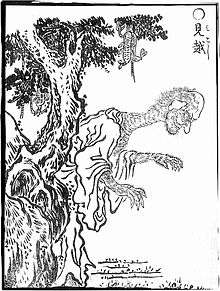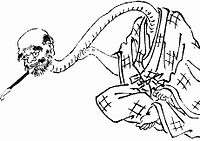Mikoshi-nyūdō


Mikoshi-nyūdō (見越し入道 or 見越入道) is a type of bald-headed yōkai "goblin" with an ever-extending neck. In Japanese folklore and Edo period (1603-1868) kaidan "ghost story" texts, mikoshi-nyūdō will frighten people who look over the top of things such as byōbu folding screens.[1] The name combines mikoshi 見越し (lit. "see over") "looking over the top (of a fence); anticipation; expectation" and nyūdō 入道 (lit. "enter the Way") "a (Buddhist) priest; a bonze; a tonsured monster".[2]
Summary
By walking to the end of a road at night or a hill road, something the shape of a monk would suddenly appear, and if one looks up, it becomes larger the further one looks up.[1] They are so big that one would look up at them, and thus are given the name "miage-nyūdō (見上げ入道 look up nyūdō)." Sometimes, if one just looks at them like that, one might die, but they seem to disappear by saying "mikoshita (見こした I've seen past you)." They most frequently appear when walking alone on night paths, but they are also said to appear at intersections, stone bridges, and above trees.[3]
It is said that getting flown over by a mikoshi-nyūdō results in death or getting strangled by the throat, and if one falls back due to looking up at the nyūdō, one's windpipe would get gnawed at and killed.[4] On Iki Island off Kyushu, a mikoshi-nyūdō would make a "wara wara" sound like the swaying of bamboo, so by immediately changing, "I have seen past the mikoshi-nyūdō (見越し入道見抜いた mikoshi-nyūdō wo minuita)," the nyūdō would disappear, but it is said that if one simply goes past them without saying anything, bamboo would fall resulting in death.[5] In the Oda District, Okayama Prefecture, it is said that when one meets a mikoshi-nyūdō, it is vital to lower one's vision to the bottom of one's feet, and if one instead looks up to the head from the feet, one would be eaten and killed.[6] Other than this, other than changing "mikoshita (seen past)" or "minuita (seen through)," there are also examples where they would disappear by mustering one's courage and smoking tobacco (Kanagawa Prefecture),[7] or by calculating the height of the mikoshi-nyūdō by a margin (Shizuoka Prefecture), among other methods.[8]
In the essay Enka Kidan (煙霞綺談) by Hakuchō Nishimura from the Edo period, the mikoshi-nyūdō is a yakubyōgami that inflicts people with fever, and there is the story as follows. In the Shōtoku era, in Yoshida, Mikawa Province (now Toyohashi, Aichi Prefecture), the merchant Zen'emon, while on the way to Denma in Nagoya, encountered a whirlwind, and the horse he rode on started to have its feet hurt, and when Zen'emon also felt unwell and started crouching, an ōnyūdō with a height of about 1 to and 3 or 4 shaku (about 4 meters) appeared. The nyūdō was almost like Nio, and as the eyes shone like a mirrors, Zen'emon came closer. When Zen'emon trembled in fear and lied down on the ground, the nyūdō jumped over him and went away. At dawn, Zan'emon stopped by a private house and when he asked, "Are there strange things like tengu around here?" he received the reply, "Isn't that what's called a 'mikoshi-nyūdō'?" Afterwards, Zen'emon reached his destination of Nagoya, but he lost his appetite, was afflicted by a fever, and even medical treatment and drugs had no effect, and died on the 13th day.[1][9]
In a certain region of the Okayama prefecture, if a female squats at a toilet, a fox (kitsune) shapeshifted into a mikoshi-nyūdō would appear and say menacingly, "wipe your butt? wipe your butt? (尻拭こうか、尻拭こうか)."[3] Also, it is said that on the night of Ōmisoka, by chanting "mikoshi-nyūdō, hototogisu" while at a toilet, a mikoshi-nyūdō would definitely appear.[3] Concerning legends like these relating to toilets, there is the theory that they may have been confused with the kanbari-nyūdō.[1]
True identity of mikoshi
There are many where the true identity of mikoshi-nyūdō is unclear, but there are regions where they are animals that possess the ability to transform. In the legends of Hinoemata, Minamiaizu District, Fukushima Prefecture, they are shapeshifted weasels, and it is said that if one gets lured to look up from the nyūdō's expansion, the weasel would take that opening and bit at one's throat. In the "Tonoigusa," they are shapeshifted tanuki, and there are also some regions where they are shapeshifted foxes (kitsune). In the Shinano Province (now Nagano Prefecture), they are said to be shapeshifted mujina.[10] Also, in the aforementioned Hinoemata, it is said that the mikoshi-nyūdō's true form is a hand-held object like a paper lantern, bucket, or rudder, and that it would be possible to exterminate the nyūdō by striking at the object.[1]
Similar tales

Yōkai similar to the mikoshi-nyūdō, such as the shidaidaka, the taka-nyūdō, the taka-bōzu, the nobiagari, the norikoshi-nyūdō, the miage-nyūdō, the nyūdō-bōzu, the yanbon, etc. throughout the country.[11][12][13]
At Uminokuchi, Minamimaki, Minamisaku District, Nagano Prefecture,[14] Akadani, Kitakanbara District, Niigata Prefecture (now Shibata), Kamikawane, Haibara District, Shizuoka Prefecture (now Honwane), Mikura, Shūchi District, also Shizuoka Prefecture (now Mori) among other places, they are told in legends simply under the name "mikoshi." In Kamikawane, there is a story where in the past, two young fellows discovered nobori-like object climbing up the night sky, and were surprised, saying "it's a mikoshi!"[1]
Also, in Ryōgōchi, Ihara District, Shizuoka Prefecture (now Shizuoka), they are also called omikoshi (お見越し), and it is said that something with the appearance of a little bōzu would talk to people at the end of a road, and in the middle of the conversation, its height would soon become taller, just continuing to look at this would result in fainting, but they would disappear by saying "I've seen through you (見越したぞ)." They are said to appear with the look of a kind person, and when a person passing along talks to it, it would grow larger depending on the contents of the conversation.[15]
In Icchōda, Amakusa District, Kumamoto Prefecture (now Amakusa), they are told in legends using the same pronunciation "mikoshi-nyūdō" but are written with different kanji, 御輿入道. It is said that they are a yōkai with a height of about 5 shaku (about 15 meters) that would appear on the road Geden no Kama, and to people who encounter them, it would lick around their lips as if it was licking them right then. A certain person encountered this, and when he prayed silently to god with all his mind, the nyūdō, without any fear of god, rode on a mikoshi-like object, and dragging out a long cloth, it flew away toward the mountain.[1]
In the kibyōshi the "Bakemono Chakutōchō (夭怪着到牒)" by Masayoshi Kitao, it appears as ama-nyūdō (尼入道), a female yōkai that has deep hair and a long neck, and this has been determined to be a female version of the mikoshi-nyūdō[16] (refer to image).
Yōkai depictions

Even while simply saying "mikoshi-nyūdō," they have been depicted as having various appearances in yōkai depictions.[17] In the yōkai emaki, the "Hyakkai Zukan" from the Edo period (refer to image) as well as the yōkai sugoroku the "Mukashi-banashi Yōkai Sugoroku (百種怪談妖物双六)," only its face and upper body have been captured in the depiction, and are thus compositions that do not make clear what characteristics they have for their body.[9][17] The mikoshi-nyūdō that has been depicted under the title "Mikoshi" in the Gazu Hyakki Yagyō by Sekien Toriyama (refer to image) is depicted covered by the shadow of a large tree, and its neck has become long, but since this is its appearance to people looking from behind, it does not mean that it is emphasizing the length of its neck like that of a rokurokubi.[17]
While mikoshi-nyūdō depicted as a yōkai with giant characteristics exists, the mikoshi-nyūdō that brings to mind the long-necked rokurokubi depicted in play images in the Edo period are certainly not strange.[17] There are those who think that they are related to the rokurokubi,[17] and since the rokurokubi of legends are frequently female, they are sometimes pointed out as examples of male rokurokubi.[18] The length of its neck has been exaggerated over the passage of eras, and in the late Edo period, it has become standard for its neck to be long and thin, and for its face to have three eyes.[9] In many kusazōshi that had a theme on yōkai, they are also depicted as having a characteristic long neck, and from having an appearance with such impact, they almost always appear as the chief yōkai.[18][19]
See also
Notes
- 1 2 3 4 5 6 7 村上健司編著 (2000). 妖怪事典. 毎日新聞社. pp. 317–318頁. ISBN 978-4-620-31428-0.
- ↑ Watanabe Toshirō (渡邊敏郎), Edmund R. Skrzypczak, and Paul Snowden, eds., Kenkyusha's New Japanese-English Dictionary (新和英大辞典), 5th ed., Kenkyusha 2003, pp. 2004 and 2490.
- 1 2 3 人文社編集部 (2005). 諸国怪談奇談集成 江戸諸国百物語 西日本編. ものしりシリーズ. 人文社. pp. 89頁. ISBN 978-4-7959-1956-3.
- ↑ 今野圓輔編著 (1981). 日本怪談集 妖怪篇. 現代教養文庫. 社会思想社. pp. 32–33頁. ISBN 978-4-390-11055-6.
- ↑ 諸国怪談奇談集成 江戸諸国百物語 西日本編. pp. 128頁.
- ↑ 佐伯隆治 (July 1938). "妖怪の名前". 民間伝承. 民間伝承の会. 3巻 (11号(通巻35号)): 5頁.
- ↑ 伊藤最子 (August 1939). "妖怪名彙". 民間伝承. 民間伝承の会. 4巻 (11号): 2頁.
- ↑ 山東善之進他 (1994). 静岡県伝説昔話集. 静岡県の伝説シリーズ. 下. 羽衣出版. pp. 70頁. ISBN 978-4-938138-08-0.
- 1 2 3 京極夏彦・多田克己編著 (2000). 妖怪図巻. 国書刊行会. pp. 140–142頁. ISBN 978-4-336-04187-6.
- ↑ 千葉幹夫編 (1995). 全国妖怪事典. 小学館ライブラリー. 小学館. pp. 110頁. ISBN 978-4-09-460074-2.
- ↑ "見越し入道(みこしにゅうどう)". 宗優子の妖怪キッズ. 2005-11-15. Retrieved 2008-12-08. External link in
|work=(help) - ↑ 志村有弘監修 (2008). 図説 地図とあらすじで読む 日本の妖怪伝説. 青春出版社. pp. 104頁. ISBN 978-4-413-00965-2.
- ↑ 多田克己 (1990). 幻想世界の住人たち. Truth in fantasy. IV. 新紀元社. pp. 96–98頁. ISBN 978-4-915146-44-2.
- ↑ 臼田福七他編 (1939). 南佐久郡口碑伝説集. 信濃毎日新聞. pp. 74–75頁.
- ↑ 全国妖怪事典. pp. 122頁.
- ↑ アダム・カバット 校中・編 (1999). 江戸化物草紙. 小学館. pp. 36頁. ISBN 978-4-09-362111-3.
- 1 2 3 4 5 湯本豪一 (2003). 江戸の妖怪絵巻. 光文社新書. 光文社. pp. 143–146頁. ISBN 978-4-334-03204-3.
- 1 2 アダム・カバット (2006). ももんがあ対見越入道 江戸の化物たち. 講談社. pp. 48頁. ISBN 978-4-06-212873-5.
- ↑ 宮本幸江・熊谷あづさ (2007). 日本の妖怪の謎と不思議. 学習研究社. pp. 93頁. ISBN 978-4-056-04760-8.